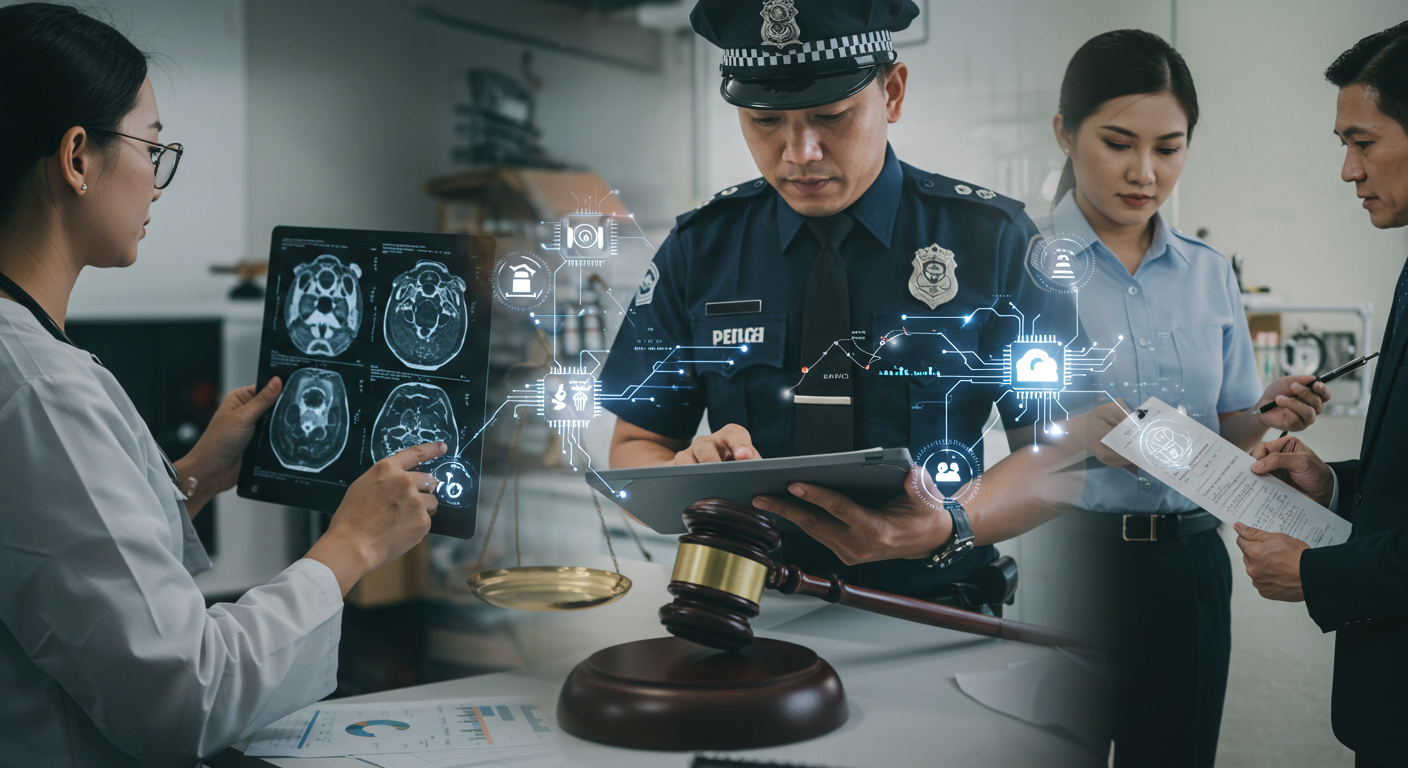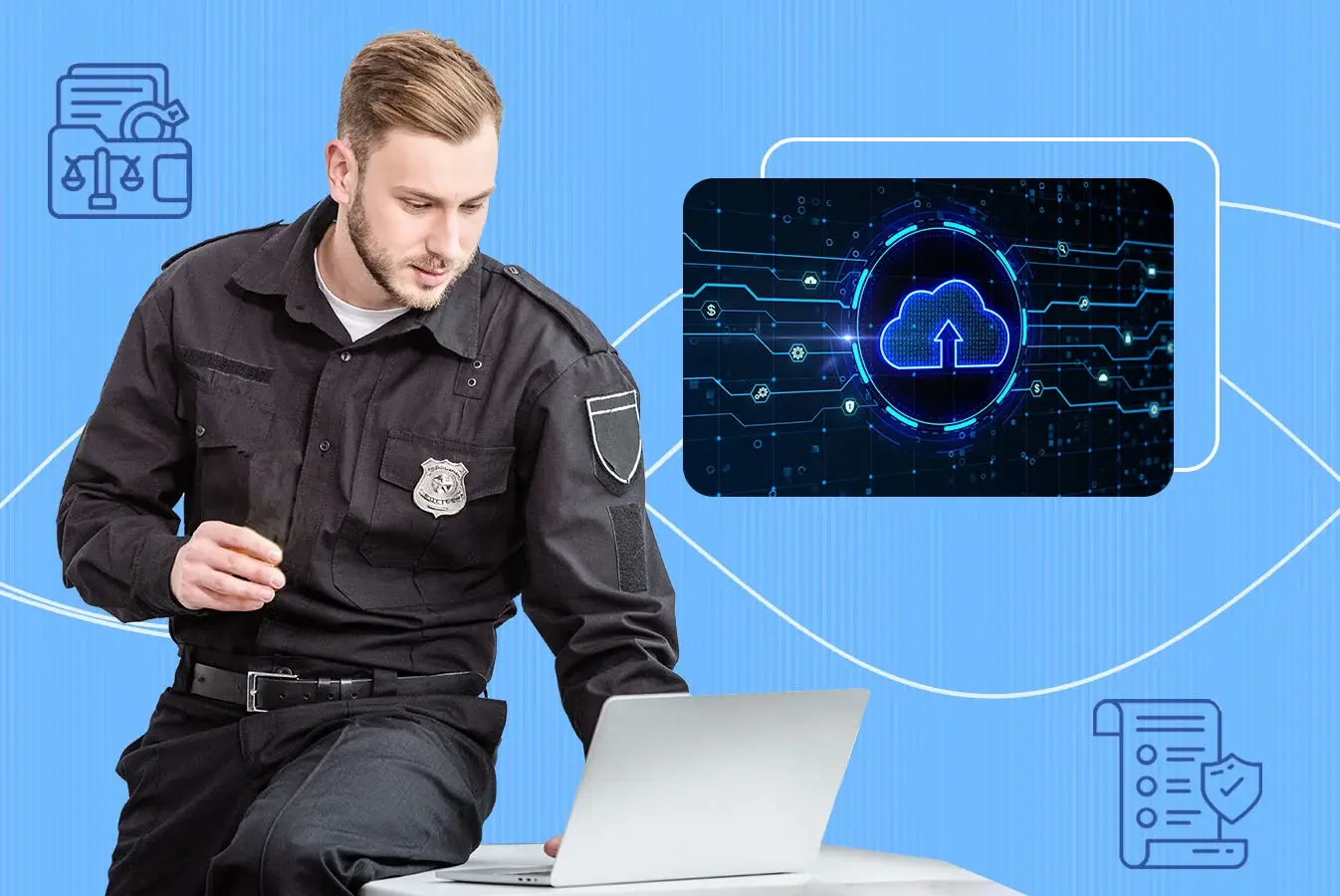A Guide to Large Language Models (LLMs) For Enterprises
by Nohad Ahsan, Last updated: November 19, 2025, Code:

Explore how Large Language Models (LLMs) and multimodal AI are transforming enterprises by unlocking smarter decision-making, data security, and scalable innovation.
A healthcare provider struggles to make timely decisions because patient records are scattered across handwritten notes, MRI images, voice recordings, and emails. Or a law firm racing against a deadline has to manually search through depositions, contracts, and evidence videos. Meanwhile, a law enforcement agency must piece together information from body cam footage, written police reports, emergency call recordings, and scanned witness statements, all under pressing time constraints. Sounds familiar?
This is where Large Language Models (LLMs), especially those with multimodal capabilities, are transforming how enterprises process and act on information. Originally designed to process and generate human language, LLMs have evolved into powerful AI systems that can understand, analyze, and create content across formats like text, video, audio, and images. For data-rich industries, this advancement enables faster, more informed decisions by unifying disparate data types into a single, intelligent workflow.
According to Gartner, by 2027, 40% of generative AI (GenAI) solutions are expected to be multimodal (incorporating text, images, audio, and video), a significant rise from just 1% in 2023. This rapid evolution reflects a growing business necessity, as enterprises seek practical ways to streamline operations, improve decision-making, and gain deeper insights from diverse data sources. Multimodal LLMs enable organizations to automate complex tasks like contract analysis, generate accurate marketing content at scale, and deliver hyper-personalized experiences by unifying insights from voice calls, emails, and customer behavior.
In this guide, we'll walk you through what LLMs are, why enterprises need multimodal LLMs, how Retrieval-Augmented Generation (RAG) enhances accuracy, and why VIDIZMO Enterprise AI Services offer a secure, scalable solution for today's data-driven businesses.
What are Large Language Models (LLMs)?
Large Language Models (LLMs) are a powerful class of AI systems designed to help organizations understand, interpret, and generate human language at scale.
What sets them apart is their ability to process massive amounts of information quickly and contextually, enabling accurate responses, summaries, and insights across everything from emails and contracts to customer conversations.

Instead of relying on simple keyword matching or rules, LLMs grasp the meaning and intent behind language, making them ideal for real-world applications like auto-generating reports, answering complex customer queries, or analyzing long-form documents in seconds.
Some key characteristics of LLMs include:
- Context Awareness: Ability to comprehend nuanced relationships within large text bodies
- Content Generation: Generate new, human-like text outputs based on prompts
- Knowledge Retention: Draw from massive training datasets spanning articles, books, forums, and more
Thanks to these capabilities, LLMs have become a strong foundation for enterprise AI, enabling more advanced solutions like multimodal models that can work across text, images, video, and audio.
Why Enterprises Need Multimodal LLMs
Enterprises generate and interact with vast amounts of diverse data every day, including emails, contracts, customer feedback recordings, marketing videos, scanned documents, and more.
Traditional AI models, which focus solely on text, can only scratch the surface of this wealth of information. Here’s why Multimodal LLMs are becoming essential for enterprises:
1. Comprehensive Data Utilization
Multimodal LLMs enable organizations to analyze and draw insights from all forms of data, not just text, but also audio calls, training videos, medical scans, and customer interactions.
For example, a hospital can use a multimodal LLM to review a patient’s medical history (text), radiology images (visual data), and recorded doctor consultations (audio) in one go. This unified analysis helps physicians reach faster, more informed decisions.
Similarly, a customer support team can review sentiment from support tickets, call center recordings, and feedback videos to improve service delivery holistically.
2. Enhanced Decision-Making
Access to multimodal data leads to smarter, faster, and more accurate decision-making.
For instance, a healthcare provider can combine patient medical records (text), MRI results (image), and recorded patient interactions (audio) to form a more complete diagnosis, reducing errors and accelerating treatment plans.
In the legal sector, attorneys can cross-reference spoken depositions (audio) with written case files (text) and scanned evidence (images or PDFs), improving the accuracy of arguments and reducing time spent on manual reviews.
This level of contextual intelligence allows enterprises to act with greater confidence and precision, whether in compliance, client service, or internal operations.
3. Increased Operational Efficiency
Multimodal LLMs streamline and automate repetitive, manual tasks that once consumed valuable employee time.
For example, HR departments can auto-generate meeting summaries from recorded onboarding sessions, categorize and tag training videos, and even extract insights from internal feedback forms and voice memos.
A compliance team can instantly transcribe regulatory webinars, summarize long-form policy documents, and flag risks from customer feedback, allowing them to respond proactively rather than reactively.
By reducing administrative burdens, enterprises can redirect human talent to higher-impact, strategic work.
4. Personalized Customer Experiences
With access to insights across various data formats from chat logs and service emails to call transcripts and product review videos, enterprises can deliver hyper-personalized experiences at scale.
For example, a telecom provider could identify customers' frustrations in recorded support calls, match them with their purchase history and service usage (text data), and automatically recommend a more suitable package during the next interaction.
This level of personalization fosters trust, loyalty, and stronger brand relationships.
5. Competitive Advantage
Multimodal LLMs offer organizations a strategic edge by enabling them to act faster and adapt better than competitors.
Consider a retail brand that uses multimodal AI to monitor social media videos, influencer content, and customer reviews alongside internal sales data to identify emerging trends and adjust campaigns in real time.
Or a financial firm that reduces decision-making time by combining analyst reports (text), market videos (visual), and earnings call recordings (audio) into an integrated market insight dashboard.
The ability to synthesize diverse data quickly allows enterprises to innovate, respond to market shifts, and outperform slower-moving competitors.
Simply put, enterprises that want to stay competitive can’t afford to ignore multimodal LLMs. They offer a practical way to make better use of data, improve decisions, and move faster in a rapidly changing business environment.
Real-World Applications Across Industries
The real power of Multimodal Large Language Models (LLMs) comes to life when applied across different industries, each with unique data types and business challenges.
Here’s how enterprises are leveraging LLMs today:
Legal Industry
As legal operations grow more complex, law firms and corporate legal departments are turning to AI for faster, more accurate legal work.
Multimodal Large Language Models (LLMs) are transforming how legal professionals handle contracts, research, and compliance.
Contract Drafting and Analysis
Law firms and legal departments use enterprise LLMs to draft, review, and analyze complex contracts, agreements, and legal documents. Trained on case law, legal templates, and regulatory directives, LLMs help streamline the contract lifecycle, reducing time-to-completion and minimizing errors.
Legal Research
Instead of manually searching vast case law repositories, attorneys use LLMs to quickly retrieve relevant cases, statutes, and regulations, saving hours of manual work and ensuring comprehensive due diligence.
Due Diligence
During mergers, acquisitions, or corporate audits, LLMs efficiently analyze mountains of legal documents and flag risks, inconsistencies, or missing clauses.
With faster research capabilities and automated analysis, LLMs empower legal professionals to work more efficiently and with greater confidence making them a powerful asset in today’s high-stakes legal landscape.
Healthcare Industry
In a field where speed, accuracy, and clarity can mean the difference between life and death, LLMs are helping healthcare organizations overcome longstanding data and communication barriers.
These AI models are reshaping how information is accessed, understood, and used across the medical landscape.
Medical Education Simplification
LLMs simplify complex medical terminologies found in fact sheets, research articles, and presentation material, making it easier for practitioners and patients to understand critical healthcare information.
Medical Data Extraction
Multimodal LLMs process medical images such as X-rays, MRIs, and CT scans, extracting structured insights that assist radiologists and medical researchers in diagnosis and reporting.
Enhancing Patient-Doctor Communication
Analyzing recorded conversations between patients and doctors, LLMs extract important medical details, flag potential risks, and assist in drafting follow-up treatment plans.
By bridging the gap between technical data and clinical decision-making, LLMs enable healthcare providers to deliver more personalized, informed, and timely care across the patient journey.
Government Sector
Government agencies are embracing AI to modernize public services, enhance policy decisions, and better engage with citizens.
LLMs are emerging as key tools in achieving operational efficiency and regulatory responsiveness at scale.
Policymaking Intelligence
Public-sector-specific LLMs help policymakers by analyzing public sentiment data, media reports, and regional statistics to craft contextually relevant and timely policies.
Permit Processing Automation
Government agencies automate permit approvals by integrating LLMs with RAG techniques to apply the most updated regulations and standards efficiently.
Citizen Communication
Multimodal AI-powered chatbots inform citizens about services, policies, and updates, improving transparency and service delivery.
From smarter governance to faster citizen support, LLMs are enabling governments to deliver more informed, accessible, and efficient services in an increasingly digital society.
Financial Services
In an industry driven by data, precision, and customer trust, financial institutions are turning to LLMs to modernize operations and deliver smarter, safer services.
From personalized banking to real-time risk mitigation, AI is reshaping financial workflows.
Product Recommendations
Banks and insurance companies use LLMs to assess customer goals, financial health, and risk tolerance to offer personalized investment advice and tailored financial products.
Risk Management and Compliance
Analyzing transaction data, market trends, and economic indicators, LLMs detect fraud, predict market risks, and support regulatory reporting.
Employee Training and Upskilling
Internal LLM-based solutions help train frontline, middle-office, and back-office employees using customized learning paths derived from organizational knowledge bases.
By applying LLMs to every layer of financial operations, institutions gain the agility to meet evolving customer needs, stay ahead of regulatory demands, and build more resilient, intelligent financial ecosystems.
Law Enforcement
With rising volumes of digital evidence and increasing pressure to deliver timely justice, law enforcement agencies are adopting LLMs to streamline investigative, prosecutorial, and compliance workflows.
These AI solutions are redefining how cases are prepared, reviewed, and resolved.
Case Preparation and Summarization
Investigators can use LLMs to automatically compile detailed case summaries for prosecutors by analyzing a combination of reports, evidence logs, body cam footage transcripts, and digital exhibits. This dramatically reduces manual effort and improves case clarity for trial teams.
Digital Evidence Review
Multimodal LLMs enable law enforcement professionals to search within digital evidence such as videos, 911 call transcripts, or surveillance footage. This helps uncover critical details quickly, improving investigative timelines and evidence handling accuracy.
Redaction and Compliance
LLMs assist in identifying and redacting sensitive data from police reports, body-worn camera footage, crash records, and other court-submitted materials. This ensures transparency while maintaining compliance with public records laws and privacy mandates.
Trial Strategy and Prosecutorial Insighs
Prosecutors can use LLMs to analyze large volumes of digital and written evidence, identify patterns, and prepare case strategies more efficiently. This ensures that legal teams can handle complex cases with stronger, evidence-backed arguments.
By accelerating investigation and improving legal accuracy, LLMs are becoming indispensable tools for modern law enforcement, helping agencies serve justice faster while upholding security, privacy, and compliance standards.
In all these industries, VIDIZMO Enterprise LLM solutions are accelerating transformation by making AI accessible, accurate, and action-driven, turning everyday operational data into a strategic asset.
Did you know? VIDIZMO designs customized AI solutions tailored to the unique needs of each customer, no matter their industry.
Overcoming AI Challenges with RAG and VIDIZMO Solutions
As powerful as Large Language Models (LLMs) are, they come with inherent challenges, the most notable being AI hallucinations and bias.
These issues, if unaddressed, can lead to inaccurate outputs, regulatory non-compliance, and even reputational damage for enterprises.

VIDIZMO tackles these challenges head-on by embedding Retrieval-Augmented Generation (RAG) into its Enterprise LLM solutions.
1. Preventing AI Hallucinations
Traditional LLMs sometimes "hallucinate," that is, they generate content that sounds plausible but is factually incorrect or misleading.
RAG minimizes this by:
- Retrieving verified knowledge from external or internal databases.
- Grounding AI outputs in factual, up-to-date information before generating a response.
- Cross-referencing multiple data points to validate results.
This ensures that every response generated by VIDIZMO LLMs is reliable, contextually accurate, and trustworthy for mission-critical enterprise applications.
2. Addressing Bias in AI Outputs
AI models can unintentionally absorb and replicate biases present in their training data.
VIDIZMO addresses this through:
- Customized model training using organization-specific, vetted datasets rather than relying solely on publicly available internet data.
- Continuous auditing and bias mitigation protocols during model updates.
- Ethical AI development frameworks that prioritize fairness and inclusivity.
This proactive approach results in fairer, more balanced AI outcomes, crucial for industries like healthcare, legal, and public sector services.
3. Maintaining Regulatory Compliance
RAG-enhanced, domain-specific LLMs are designed to:
- Reference the latest regulatory changes.
- Provide audit trails for decision support.
- Align outputs with industry-specific compliance requirements.
Thus, enterprises avoid the risk of regulatory penalties while staying ahead in operational innovation.
VIDIZMO’s Enterprise LLM solutions are built for justice and public safety agencies, enabling secure, efficient, and compliant digital evidence processing across departments
In summary, by leveraging Retrieval-Augmented Generation (RAG) and a secure-by-design philosophy, VIDIZMO empowers enterprises to deploy LLMs that are not just intelligent but also safe, ethical, and enterprise-ready.
Unlocking Enterprise Potential with LLMs
In today’s fast-evolving digital landscape, deploying a secure and scalable LLM solution is no longer a luxury; it’s necessary for enterprises aiming to remain competitive. Large Language Models have moved beyond simple text generation to become powerful business transformation engines capable of processing text, audio, video, and images through multimodal AI innovations.
By leveraging Enterprise LLMs that utilize Retrieval-Augmented Generation (RAG), organizations can ensure the factual accuracy of outputs, eliminate AI hallucinations, and maintain compliance with industry regulations like GDPR and HIPAA. This approach not only enhances operational efficiency but also unlocks smarter decision-making and richer customer experiences.
At VIDIZMO, we specialize in delivering tailored Enterprise AI Services designed to meet your unique business challenges. Whether you need an LLM deployed on-premises, in a private cloud, or via a geo-restricted SaaS setup, our solutions ensure data confidentiality, regulatory compliance, and seamless integration with your existing IT infrastructure.
Ready to explore the future of enterprise AI? Explore Our AI Services or Contact Us to see how we can support your AI journey.
People Also Ask
What is a multimodal LLM, and how does it work?
A multimodal LLM is a large language model capable of processing and generating outputs from multiple data types such as text, audio, video, and images. It works by using specialized encoders for each format and combining the extracted information into a unified understanding, enabling more comprehensive AI-driven solutions.
Why should enterprises consider deploying an LLM?
Enterprises should deploy an LLM to improve decision-making, automate content generation, enhance customer experiences, and manage complex datasets more efficiently. With the integration of multimodal AI and techniques like Retrieval-Augmented Generation, LLMs offer businesses a competitive advantage through smarter, faster insights.
How does Retrieval-Augmented Generation (RAG) benefit enterprise LLMs?
Retrieval-Augmented Generation benefits enterprise LLMs by grounding generated outputs in real-time, verifiable information. This technique significantly reduces hallucinations and ensures the accuracy and reliability of responses, which is critical for industries like finance, healthcare, and legal services.
What are the advantages of multimodal large language models for businesses?
Multimodal large language models allow businesses to extract insights from various formats, leading to better customer understanding, faster decision-making, and increased operational efficiency. By utilizing text, video, audio, and image data, enterprises can maximize the value of their information assets.
Can an enterprise LLM solution ensure data security and compliance?
An enterprise LLM solution can ensure data security and compliance when deployed using secure infrastructures like on-premises or private cloud environments. Providers like VIDIZMO offer solutions that comply with regulations such as GDPR, HIPAA, and CJIS, safeguarding sensitive information throughout the AI lifecycle.
How do large language models transform customer service operations?
Large language models transform customer service operations by powering intelligent chatbots and virtual assistants capable of understanding customer queries across different formats. They enhance responsiveness, personalize interactions, and reduce the workload on human support teams.
Why is bias mitigation important in enterprise LLM development?
Bias mitigation is important in enterprise LLM development because biased outputs can lead to legal risks, poor customer experiences, and damaged brand reputation. Businesses can ensure fairness and ethical AI practices by training LLMs on curated, domain-specific datasets and applying continuous auditing processes.
What makes VIDIZMO’s LLM development services unique for enterprises?
VIDIZMO’s LLM development services are unique because they offer multimodal capabilities, Retrieval-Augmented Generation for accuracy, flexible deployment models, seamless integration with enterprise systems, and a strong emphasis on data security and regulatory compliance.
Jump to
You May Also Like
These Related Stories

Why Cloud Adoption is Crucial for Modern Law Enforcement

How DEMS Enhances Police Decision-Making and Efficiency



No Comments Yet
Let us know what you think